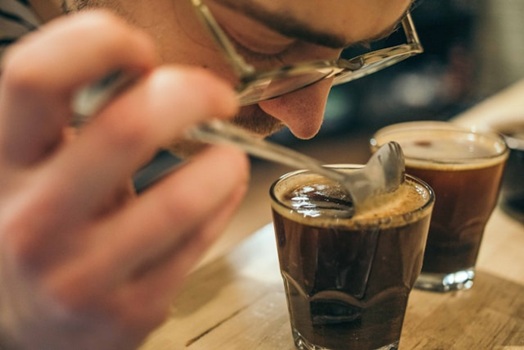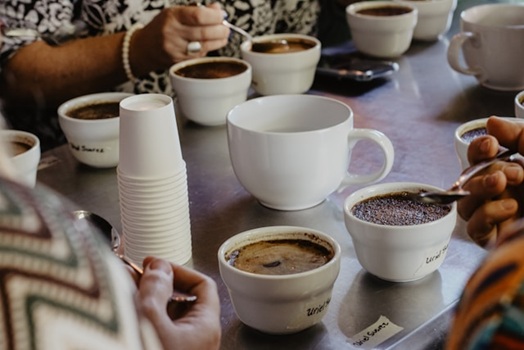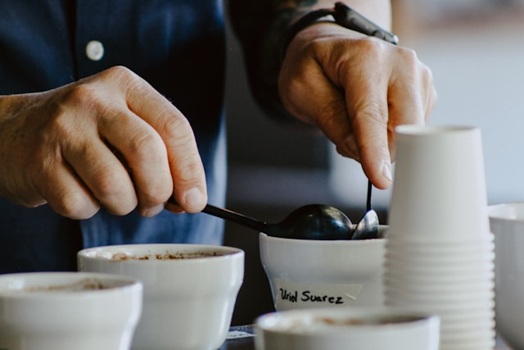Coffee cupping is a technique used to evaluate the aroma, flavor, and quality of coffee. It involves tasting different coffees side by side under controlled conditions. You grind the beans, add hot water, and smell the aroma. Then you slurp the coffee to get the full flavor. It helps you spot the differences in taste, body, and acidity. To master it, you need practice, proper technique, and a keen sense of taste and smell.

Coffee cupping is a hands-on way to examine the unique flavors, aromas, and textures of different coffee beans. Professionals around the world use it, which helps evaluate coffee for quality, consistency, and flavor notes.
But you don’t need to be an expert to start cupping; anyone can do it at home with a few basic tools and a curious palate. In this blog, I’ll teach you how to master coffee cupping step by step. It’s a fun, hands-on way to really get to know your coffee!
What is Coffee Cupping?
Coffee cupping is a method of tasting coffee used to evaluate its qualities, such as aroma, flavor, and overall profile. It is typically done in a controlled environment where variables like grind size, brewing time, and water temperature are standardized. Cupping allows coffee professionals to compare various coffee beans side by side to assess their characteristics like acidity, body, aroma, mouthfeel, cleanness, sweetness, and aftertaste.

Coffee cupping started out of pure necessity in the bustling coffee markets of the 19th century. Traders and merchants needed a quick, reliable way to evaluate beans before making big purchases. The practice really took off in the early 1900s when coffee companies like Folgers and Maxwell House hired professional tasters to maintain consistent quality across their blends.
The modern cupping protocol we use today was refined in the 1980s by the Specialty Coffee Association, creating universal standards that coffee professionals worldwide could follow.
Why is coffee cupping important?
Coffee cupping is important for the following reasons:
- Quality Control: Coffee roasters and importers use cupping to maintain consistent quality across batches. It helps them catch defects early and ensure every bag meets their standards before it reaches customers.
- Flavor Profiling: Cupping reveals each coffee’s unique personality—whether it’s fruity, nutty, or chocolatey.
- Consistency: By using standardized methods, coffee cupping allows for accurate comparisons between different coffee beans or batches, helping to maintain consistency in the final product.
- Decision Making: For roasters, cupping is an important tool to decide which beans to purchase, roast, and sell. It helps them choose beans that will produce the best results in their specific roasts.
What Is The Difference Between Coffee Tasting And Cupping?
There are notable differences between coffee tasting and cupping. Coffee tasting is more casual and can happen anywhere, from your kitchen to a coffee shop. It’s a personal experience where you evaluate coffee based on your preferences.
Coffee cupping, on the other hand, is a formalized process used by professionals to evaluate and compare coffee beans. It involves a standardized procedure, including specific ratios of coffee to water, grind size, and precise methods for tasting.
Think of cupping as the scientific approach and tasting as the fun, exploratory approach to experiencing coffee.

Can anyone Cup?
Yes, anyone can participate in coffee cupping. While professional cuppers have more experience, anyone interested in learning about coffee can start cupping at home.
It’s a great way to train your palate and develop a deeper appreciation for coffee’s complexities. You can join cupping sessions at local roasteries or set up your own cupping experience at home with the right equipment and a little guidance.
How to Do Coffee Cupping?
To get started with coffee cupping, you will need a few basic tools and ingredients:
The method is taken from Coffee Value Assessment-SCA Standard 102-2024
What do you need?
- Coffee beans: Preferably freshly roasted and ground to a coarse consistency.
- Hot water: Heated to about 200°F (93°C).
- Cups: Standard cupping bowls (usually clear glass) to hold the coffee.
- A spoon: Deep cupping spoons, if possible
- Timer: To keep track of steeping times.
- Scale: For measuring the coffee and water.
- A grinder: To grind the coffee beans.
- A notepad: To dial in coffee characteristics
Step by Step Instructions
Here’s a simple guide on how to cup coffee:
- Prepare and Coffee grounds: Use about 13-15 grams of coffee per cup (a standard is a 1:15 ratio). Grind it medium-coarse, like sea salt. Do it fresh, right before cupping.
- Smell the Dry Coffee: Add the coffee grounds to the cup. Then, get close and take a deep sniff. You’re looking for the first impression—is it floral, nutty, fruity, or earthy? This dry fragrance tells you a lot about the coffee’s potential.
- Boil the Water: Heat your water to about 200°F (93°C). It should be just off the boil to avoid burning the coffee.
- Add Coffee to Cups: Place the ground coffee in your cups. Be sure to use clear cups to evaluate the coffee’s appearance and color later on.
- Pour Water Over Coffee: Slowly pour the hot water into the cups, saturating the coffee grounds. Fill each cup to the top.
- Let It Steep: Allow the coffee to soak for about 4 minutes. This is when the coffee will form a crust on top.
- Break the Crust: After steeping, use a spoon to crack the crust of coffee that has formed on top. Immediately lean in and smell—this “wet aroma” is often the most intense and revealing moment. Note what you pick up.
- Clean the Surface and Let it cool: Use your spoons to skim off the foam and floating grounds from the surface. You want clean, clear coffee for tasting. Wait another 5-10 minutes for the coffee to cool to around 160°F. This temperature lets you taste without burning your tongue while still getting the full flavor profile.
- Scoop and Taste: Use your spoon to slurp the coffee. The slurping sprays coffee across your entire palate, hitting all your taste buds at once. Take notes on what you taste: acidity, sweetness, body, and specific flavors.
- Evaluate and Score: Evaluate the coffee based on various attributes (discussed below) and give it a score for each attribute.

Coffee Cupping Tips
- Consistency Is Key: Use the same equipment, timing, ratios, and technique for every sample. Consistency matters more than perfection—if you break the crust the same way each time, you’ll get reliable results.
- Spit, Don’t Swallow: Professional cuppers spit out samples to avoid caffeine overload and palate fatigue. Too much caffeine dulls your ability to detect subtle flavors.
- Start Simple: Focus on the big picture first—sweetness, acidity, body, and aftertaste. Once you master these basics, then dive into specific flavor notes like chocolate or berries.
- Clean Equipment: Clean your cups and spoons thoroughly between cuppings to avoid cross-contamination of flavors.
- Take Notes: Write down your findings of each coffee to track differences in aroma, flavor, and overall profile.
How to Describe Coffee Flavors and Aroma?
Here’s a breakdown of the main descriptors used in coffee cupping:
- Aroma: This is the first impression you get from a coffee. Good coffee will have an inviting aroma, with notes that could range from floral to fruity to nutty.
- Acidity: Acidity in coffee is the bright, tangy sensation that can be similar to a citrus fruit. A high-quality coffee will have a balanced acidity.
- Mouthfeel: The Mouthfeel of a coffee refers to its body. A coffee with a full body will feel heavier and thicker on the tongue, while a light-bodied coffee will feel more delicate.
- Sweetness: Coffee sweetness refers to the natural sugars in coffee. A sweet coffee will have pleasant, honey-like or caramel-like notes.
- Flavor Notes: Flavor notes are the specific tastes you detect when drinking coffee. These can include fruity, nutty, spicy, or even chocolatey flavors.
- Aftertaste: The Aftertaste describes the lingering finish of coffee. A good finish is clean and pleasant, without any unpleasant or bitter aftertaste.
- Astringency and Bitterness: Astringency is a drying sensation in the mouth, while bitterness refers to the harsh, sometimes unpleasant flavor that can result from over-roasting or over-brewing coffee.
- Overall: It’s about how you perceive the coffee as a whole, pulling together everything from the earlier factors.
How Is Coffee Cupping Scored?
Coffee cupping is scored using the SCA 100-point scale. Each cup gets rated across multiple attributes, and the total score determines whether it’s specialty grade (80+ points) or commercial grade.
- Fragrance and Aroma
- Flavor
- Aftertaste
- Acidity
- Body
- Balance
- Uniformity
- Clean Cup
- Sweetness
- Overall Impression
You can use the SCA’s Total Affective Score tool to calculate precise coffee evaluations. This official tool lets you input your final scores for each section and accounts for defective or non-uniform cups to calculate the total score under SCA’s Coffee Value Assessment system.
FAQs
What is Specialty Coffee?
Specialty coffee refers to high-quality coffee beans that are graded 80 or higher on the 100-point scale by professional cuppers. These coffees are grown in ideal conditions, carefully processed, and roasted with great attention to detail. Specialty coffee is known for its exceptional flavor profile, complexity, and consistency.
Can I do coffee cupping with instant coffee?
While you technically can cup instant coffee, it won’t provide the same experience as cupping freshly brewed coffee. Instant coffee lacks the complexity and flavor profile of freshly ground beans, so the cupping process won’t yield meaningful insights.
Why is slurping important during cupping?
Slurping is an important part of the cupping process because it aerates the coffee, allowing it to spread evenly across your palate. This helps you experience the full range of flavors, aromas, and textures. It’s also a way to break the coffee’s surface tension and release more aromas.
What Brewing Method for Cupping?
Coffee cupping uses immersion brewing—the simplest method possible. You pour hot water directly over coarsely ground coffee and let it steep for 4 minutes, just like making French press coffee but without the plunger. It’s all about keeping it simple to focus on flavor.



